The City, the Sparrow, and the Tempestuous Sea
The saltmarsh sparrow survives the rattle and roar of one of North America’s most populated areas, but its greatest challenge comes from the sea.
Article body copy
This article is part of Birdopolis, a three-part series that explores the lives of birds that are, by accident or design, spending more time in urban environments. The other stories are “The Gull Next Door” and “Honolulu: A Seabird’s Surprising Five Star Destination”.
For insights into the urban lives of another group of coastal birds—gulls—watch the recording of our webinar “Birdopolis: Coastal Birds at Home in the City.”
Today, the name of the park preserve—Idlewild—seems aspirational. Snugged up against the northwest border of John F. Kennedy International Airport in the New York borough of Queens, population 2.2 million, the green space, approximately one-fifth the size of nearby Central Park, is a remaining sliver of the expansive wetlands that once carpeted the Atlantic coastline. It’s also some of the only habitat remaining for one of North America’s endangered birds, the saltmarsh sparrow. And in their little patch of wild, female saltmarsh sparrows are hardly idle. Undeterred as jets fly overhead every five minutes or so, females flit and dip through the grasses, hurriedly building nests so that they can lay their eggs and raise them to fully fledged chicks, all within one lunar cycle.
I’ve joined Alex Cook, a biologist at the State University of New York College of Environmental Science and Forestry (SUNY ESF), and her team of four in Idlewild this July 2019 morning, already steamy at 5 a.m., to learn more about their work and the saltmarsh sparrow. As we load up the gear, I notice the stark contrast between our knee-high rubber boots—mine, shiny black and newly purchased; theirs, mud-caked and sun-bleached—and rightly predict what the day has in store. Within 100 meters of entering the wetlands, I’m breathing loudly and heavily, trying to keep up with the all-female team skirting along a barely discernible path through the sloppy mud.
With each step the mud reaches halfway up my boots. The suction feels powerful enough to pull them off my feet.
“Don’t worry,” Cook says. “It’ll go over your boots by the end of the day. It’s inevitable.”
Eventually, I free myself and carry on into the marsh.
When I looked up the saltmarsh sparrow in preparation for this trip, I knew I wouldn’t be much help in the ID department. To me, the bird looked like an LBB, or “little brown bird,” the informal name birders sometimes use for any small brownish bird that is difficult to identify. Its picture showed lots of grays and browns, streaks and spots, but the white throat and the orange “eyebrow” seemed like good clues. I am in excellent hands with Cook and her team, though. Cook’s program at SUNY ESF has been studying the birds since 2011 as part of the Saltmarsh Habitat and Avian Research Program (SHARP), an umbrella organization that amasses data on tidal marsh birds for various research groups. And I’d certainly be excused for never having seen a bird so rare. Once, a population of 250,000 saltmarsh sparrows bred in a 1,000-kilometer-long strip of coastal wetlands from Maine to the Chesapeake Bay. Now, only an estimated 60,000 birds hang on in a few remaining pockets of breeding habitat.
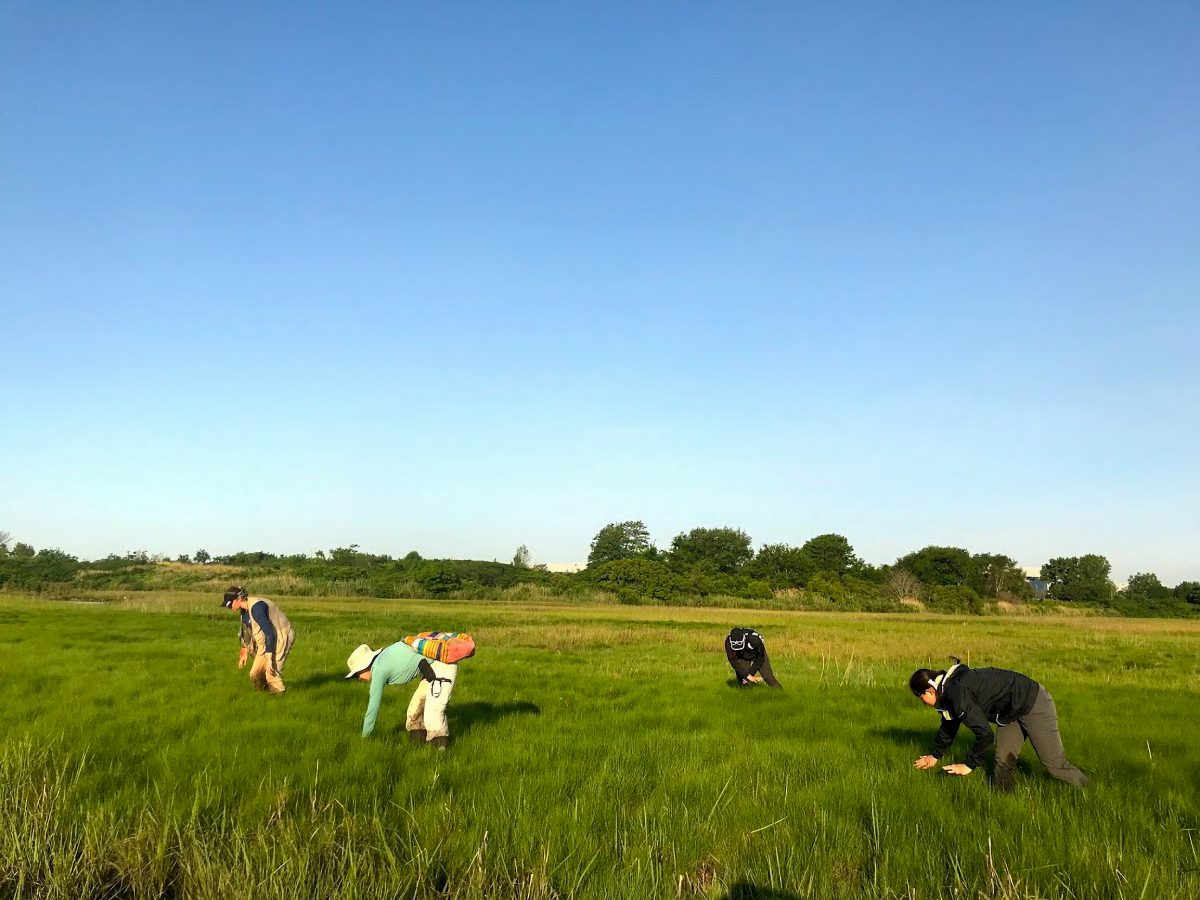
A team of researchers from the State University of New York College of Environmental Science and Forestry (SUNY ESF) search for saltmarsh sparrow nests in Idlewild Park Preserve, New York City, New York. Photo courtesy of Alex Cook
In addition to having specific breeding locations, saltmarsh sparrows also have a specific breeding time frame—one that is dictated by the movement of the moon around the Earth, and the tides this celestial dance creates. Because the sparrows build their nests exclusively in coastal wetlands that are susceptible to flooding, their reproductive cycle relies on this predictable sequence—they have carved out a niche to raise their young in these coastal wetlands between the lunar flooding that occurs every 28 days on the highest of high tides.
But global warming—with accelerated sea level rise, more volatile weather conditions, and even a shift in global wind directions that floods or dries out coastal wetlands—has disturbed this delicate balance. Habitat destruction has further whittled this already small strip of suitable breeding ground down to a sliver.
All of this leads to a bird with an uncertain future. In the last two decades, the saltmarsh sparrow population has declined by 75 percent, a shockingly precipitous decrease leading scientists to believe that within 15 years the saltmarsh sparrow could join the passenger pigeon and the Carolina parakeet on the list of birds of the continental United States that have been erased from the face of the Earth forever.
Carrying bags teeming with equipment—transponders, calipers, bamboo poles, folding chairs, umbrellas, water, food, a tarp, and thin netting bundled up in threadbare plastic bags—we push through hip-high mugwort plants and reeds that stretch over our heads into the hazy sky above. The marsh smell is a strange amalgamation of swamp stench—hydrogen sulfide, methane, sulfur—and jet-fuel exhaust. Likewise, there is a peculiar discordance of noise—pulsating airplane engines mixing with the sounds of nature. We set up a field camp on a patch of damp, tamped-down grass just a few feet from a canal. The canal water is interspersed with shimmering, iridescent oil slicks that capture the rising sun in psychedelic explosions of color. Waxy white patches slowly float out to sea like cartwheeling snowflakes. The humidity is thick enough to chew. It is barely daybreak, but already oppressively hot, as if the sun were boiling the marsh. Everything is soggy. If you stand too long in one spot, you begin to sink.
Despite the pollution, the airport, and surrounding development, the Idlewild Park Preserve remains a dynamic and vibrant ecosystem, teeming with vegetation, insects, and birds. The park is part of the greater Jamaica Bay wetlands, which are a renowned haven for over 325 species of birds—nearly a third of all species found in North America. As the researchers set up the field camp, I spot bleach-white great egrets, black skimmers, cedar waxwings, yellow-crowned night-herons, and red-winged blackbirds, to name only a few.
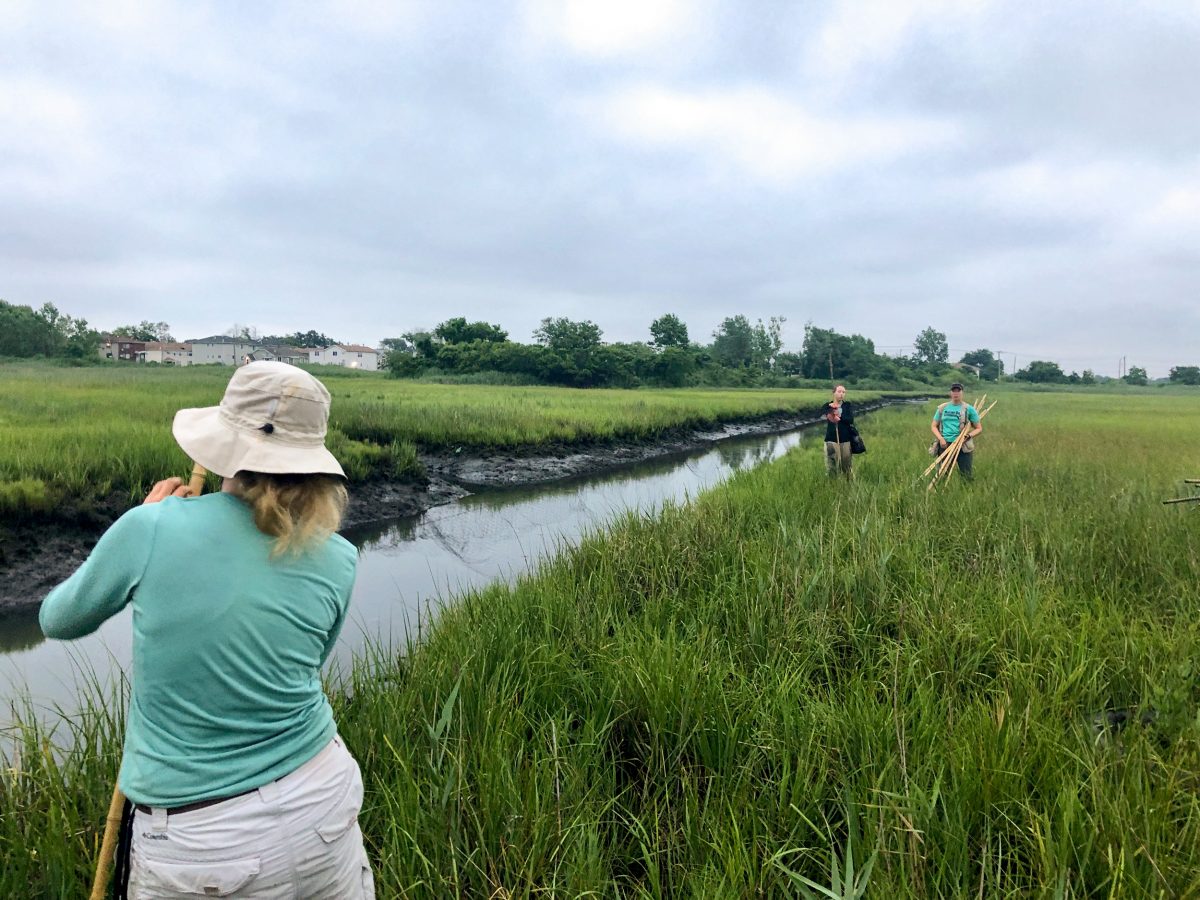
The SUNY ESF team sets up a mist net. They will use it to catch saltmarsh sparrows and briefly retain them for measurements and banding. Photo by Joseph Quaderer
Once the roar of the jets momentarily subsides, we can hear the calls and songs of the many birds that live in the preserve. The saltmarsh sparrow call is conspicuously absent. Most birds, especially songbirds, sing to declare a territory or to attract a mate. But saltmarsh sparrows are not like most birds—they are notoriously promiscuous. Typically, avian parents pair up to take care of young birds. Occasionally, birds will have “extra pair copulation,” behavioral ecologists’ term for screwing around, but saltmarsh sparrows bring extra pair copulation to a new level—males mate with multiple females and females mate with multiple males. Because saltmarsh sparrows don’t form pairs, the males don’t need to be territorial. The females never sing, and the males’ only song is a mating call. As a result, they are naturally more muted than other species, but even those muted calls are getting quieter and quieter each year.
Wild birds are subject to a litany of assaults—attacks by domestic cats (estimated to cause between 1.3 and four billion deaths a year in the United States alone), collisions with buildings and windows (up to another billion), pollution, and habitat destruction. But nothing poses an existential threat to birds the way climate change does. In 2014, the National Audubon Society conducted a study on 588 North American species of birds and concluded that over half of that population will lose more than 50 percent of their current climatic range by 2080.

Idlewild Park Preserve is adjacent to the John F. Kennedy International Airport, and wildlife in the preserve, and human visitors, are subject to a low-flying jet every five minutes or so. Photo by Anna Peel
One of the major consequences of climate change is an increase in the pace of sea level rise, which is currently increasing three to five millimeters per year on the eastern coast of the United States. Even though the world’s oceans are connected, sea level rise is uneven, with the eastern coast of the United States experiencing rises considerably faster and higher than the global mean.
Historically, in salt marshes such as Idlewild, gradual sea level rise wasn’t an issue because, among other things, the marshes had the capacity to expand inland, where conditions were more accommodating. But today, artificial barriers such as roads, buildings, and dams block this natural creep.
Sea level rise also affects how often salt marshes are flooded. There are multifarious types of grasses growing in the marshes and some are better suited than others to withstand these more frequent inundations. The increased flooding is affecting the specific grass the saltmarsh sparrow prefers to nest in. Ultimately, climate change is not only reducing the available saltmarsh breeding habitat size, but also its quality.
The verdantly green vegetation carpeting the interior of the Idlewild Park Preserve is beautiful—fields of long, swaying grass sigh in the salty offshore winds of the Atlantic. To the untrained eye, the salt marsh looks homogenous, but it’s a finely tuned ecosystem calibrated to even the slightest variances in elevation. Height above sea level affects the likelihood of an area being inundated with salt water, and that in turn affects the vegetation that grows there. Mere centimeters can demarcate which areas are considered “high marsh” or “low marsh.” The vegetation the saltmarsh sparrow nests in is supremely attuned to these nuances.
The saltmeadow cordgrass (Spartina patens), a wispy, hay-like species native to the Atlantic Coast, grows in higher elevations in the marsh that are less likely to flood with storm surges. It’s the favored nesting habitat for saltmarsh sparrows, but with global warming causing more volatile weather conditions and increased flooding, the saltmeadow cordgrass is declining.
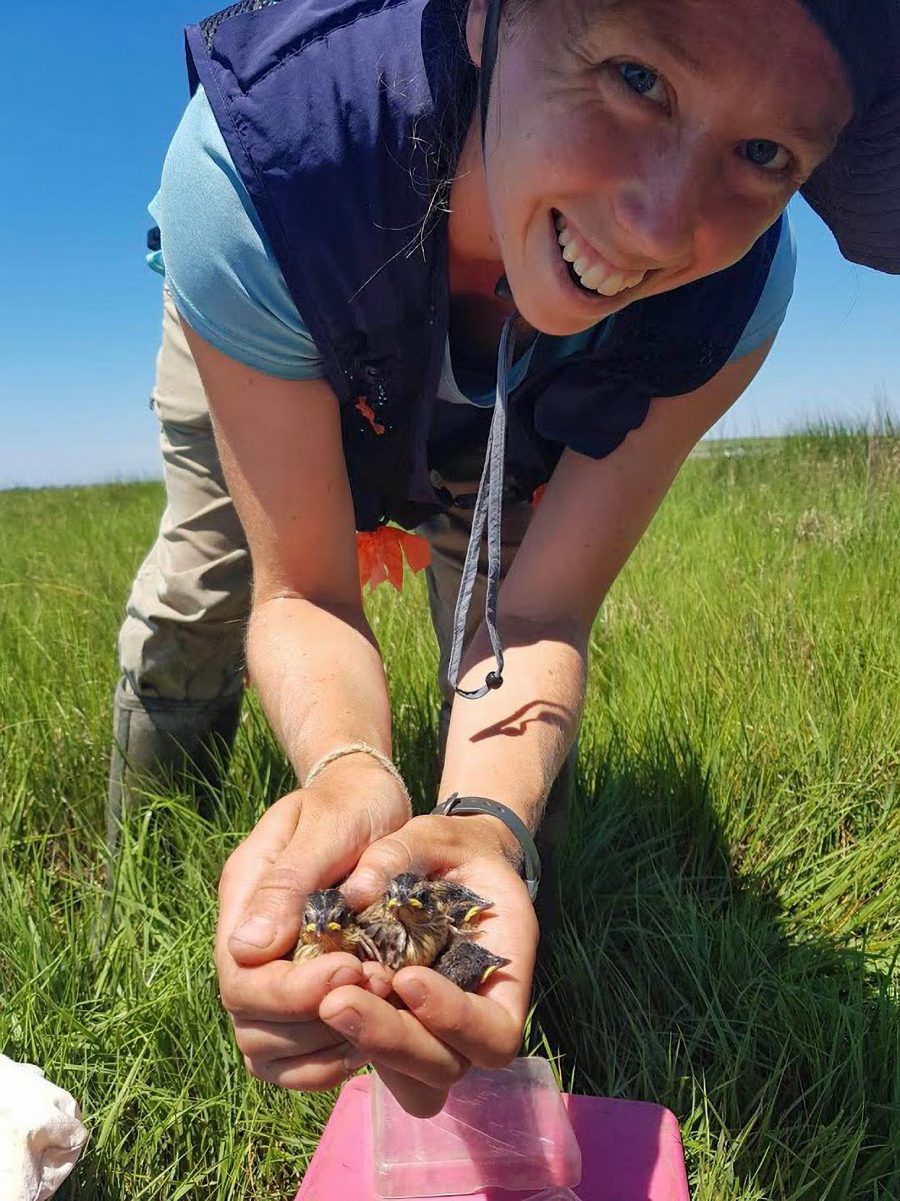
Biologist Alex Cook, lead of the SUNY ESF team, with several saltmarsh sparrow chicks briefly removed from their nest. Photo courtesy of Alex Cook
Cook and I trudge through the fields of saltmeadow cordgrass, sticking bamboo poles into the muck, and stretching thin black mist nets—finely woven nets that will be used to catch the birds—between them. Even though we’re at a relatively high elevation in the marsh, larger detritus deposited during storm surges peeks through the bursts of bright green grass: car and truck tires, some with metal rims; glass bottles—Johnnie Walker Black Label, Bud Light; and a once-black Valvoline oil container bleached gray by the sun. Throughout the marsh, the intersection of human refuse and natural bounty is omnipresent, yet perpetually jarring.
Closer to the tendrils of water—stretching like crooked fingers into the salt marsh—is the smooth cordgrass (Spartina alterniflora), a thicker, ribbonlike grass that can withstand more frequent flooding.
A few weeks later, I’ll meet with Chris Elphick, an avian specialist in the Department of Ecology and Evolutionary Biology at the University of Connecticut, in the salt marsh at Hammonasset Beach State Park to learn more about these grasses and saltmarsh sparrows, which he’s studied for 20 years. As we walk through the Connecticut salt marsh, our shadows long in the mid-July, late-afternoon sun, he tells me about a study he did in the early 2000s, in which he analyzed vegetation around the saltmarsh sparrow nests in nearly every major marsh system in Connecticut, around 60 study plots in all. When the same vegetation plots were resurveyed in 2013, everything had changed—across the board, the smooth cordgrass was more common, and the saltmeadow cordgrass was less common.
“So the vegetation is shifting in a way that indicates the marshes are being flooded more often,” Elphick tells me.
Back in the Idlewild Park Preserve, as Cook and I walk through the marsh setting up the final mist nets, I note that the perimeter of the marsh is lined with the European common reed (Phragmites australis), which is invasive in American wetlands and is dramatically altering the sparrow’s already dwindling habitat. The hardier, more robust species, which grows to four meters in height, is not only altogether unsuitable for nesting, but it also hoards the sunlight and further decimates the grasses the saltmarsh sparrow can breed in.
“The vegetation for saltmarsh sparrows keeps getting worse and worse, but they’re still here,” Cook says as we set up the last mist net. “Either they’re adapting or they’re at their limit.”
Available vegetation dictates where saltmarsh sparrows breed, but the tidal cycles dictate when they breed. The highest spring tide, most likely to flood a salt marsh, occurs every 28 days. Saltmarsh sparrows have evolved to breed in between these flooding periods.
In the best-case scenario, it takes 22 days for the saltmarsh sparrow chicks to fully develop into functional birds and 27 days in the worst-case scenario. Because they primarily create their nests higher up in the marsh, in the saltmeadow cordgrass, the nests typically only flood during the month’s highest tide. If the salt marshes flood every 28 days, the mothers still have enough time to lay the eggs and the chicks have enough time to develop and fledge the nests.
But if the nests flood more frequently, it can be calamitous.
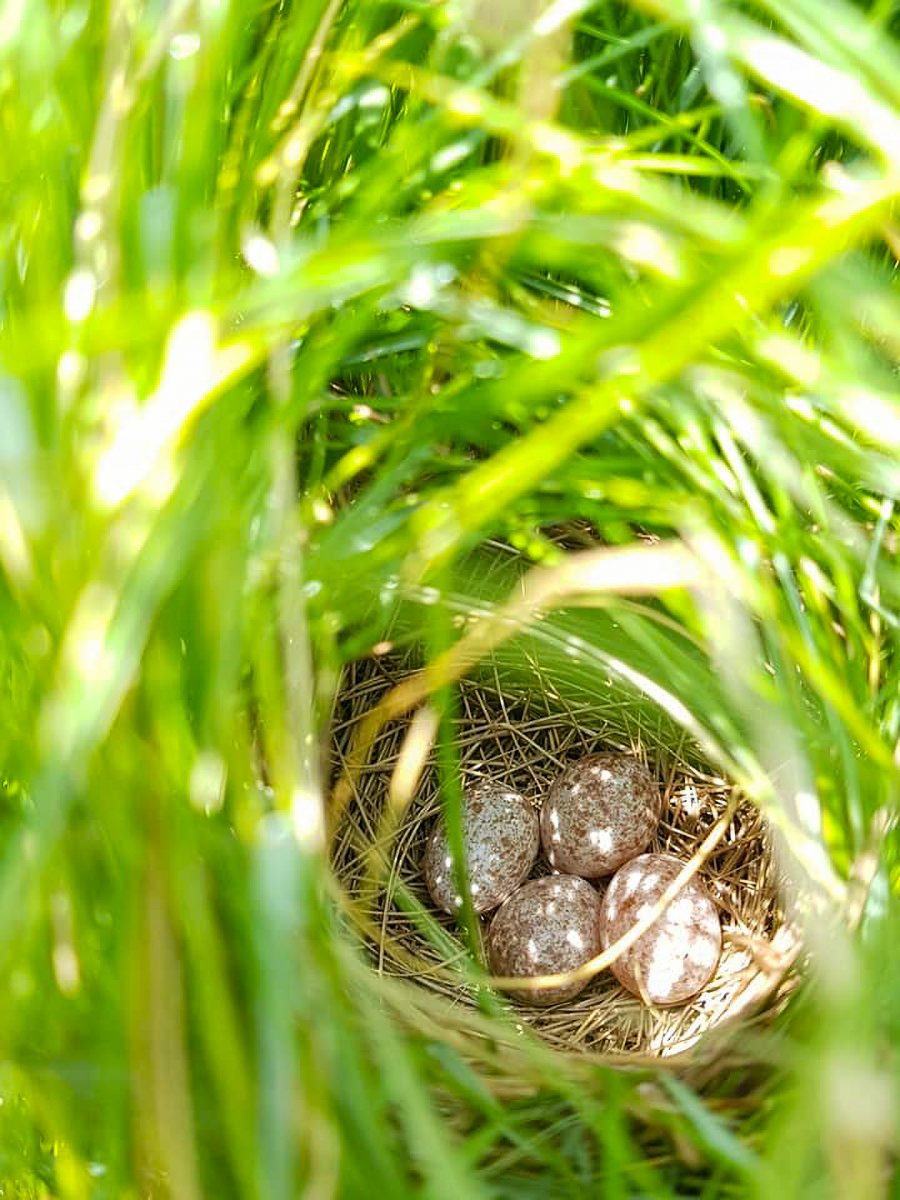
Saltmarsh sparrow nests are particularly vulnerable to flooding. If the nest washes away on a high tide, the birds often try again—making a new nest, laying a fresh clutch of eggs, and seeing them hatch all within one lunar tide cycle. Photo courtesy of Alex Cook
During some spring tides or when there are storm surges—caused primarily by the strong winds in a hurricane or tropical storm, which have both worsened with global warming—the mother is forced to flee when the nest floods. Saltmarsh sparrow eggs can remain submerged for up to 90 minutes with no adverse consequences, but if they float out of the nest they die because there is no way for the mother to get the eggs back in the nest to properly brood them.
In 2009, Elphick worked with a graduate student whose study included locating saltmarsh sparrow nests in two Connecticut salt marshes. The student found over 200 nests at Hammonasset Beach State Park and another nearby marsh. But it was a wet and stormy year, with increased wind and flooding. The nests flooded so frequently that the saltmarsh sparrows never had enough time to raise their young. Out of over 200 nests, only about 10 saltmarsh sparrow chicks survived.
“There will reach a threshold when the flooding comes too often to allow the birds’ time to raise their young,” Elphick says. “After that threshold is crossed, the birds may have five or six years before they’re extinct.”
Thirty minutes after setting up the mist nets, we go back into the field, collect a half-dozen captured birds, and bring them back to camp. The researchers work quickly and systematically, recording the specifics of each bird. Using calipers, they measure obscure bird body parts: tarsus, wing chord, skeletal culmen, and nalospi. They poke a needle into a vein under each bird’s wing and use capillary tubes to withdraw fire truck–red blood for DNA and mercury testing. They place the birds in thin tan stockings to weigh them. All of this information will go to SHARP to help assess the strength and migratory habits of the population and note the development of birds they had previously examined.
After a brief lunch, the team sets out upon their second task of the day—monitoring the nests. Although each nest is marked by a fluorescent orange flag, they are still surprisingly hard to spot. We remain on the paths so we don’t step on the nests or wash out the eggs with the splashing from our boots.
Cook, technician Anna Peel, and I examine nearby nests while the rest of the team checks nests in the far corners of the salt marsh. Even though the researchers monitor the nests every three or four days, it still takes a bit of searching to find them. In addition to understanding which areas of the marsh and which types of vegetation the birds are selecting for nests, the researchers want to gather information about the specifics of each nest.

The SUNY ESF research team quickly takes a suite of measurements on a saltmarsh sparrow caught in a mist net. Photo by Joseph Quaderer
First, we come across an abandoned nest. While Cook stands with a clipboard waiting to record information, Peel crouches down—her multi-pocketed field vest chock-full of scientific equipment brushing against the top of the grass—and sets up a one-meter perimeter around the empty nest, gently burrowing a measuring stick into the grass and thatch. Then she uses another measuring stick—green and barely thicker than a drinking straw—to note the average height of the grass and thatch.
We continue walking and spot another palm-sized nest nestled deep in the grass. Although we approach cautiously and gently, the mother flees before we ever see her. Furtive creatures. At active nests, the researchers move quickly to minimize the disturbance for the mother. Peel peeks into the nest to see how any fledgling birds or eggs are faring.
Saltmarsh sparrow clutches typically contain three to five eggs. This nest has one hatchling, a tiny featherless creature with its eyes still glued closed. Cook briefly removes it and colors its leg red with a harmless marker so the other researchers would know it has been discovered and recorded. She holds it for me to look at. The bird is calm and quiet. At the second active nest, she counts one egg. She plucks it from the nest and cups it in her palm to gauge its temperature.
“It’s cold,” she says. That means it’s dead. Cook is matter-of-fact when noting this. It’s not something she wants to see, but with the tide rising this morning the team needs to work quickly and there’s no time to linger. The third active nest has four live eggs. The last has three cold eggs: two in the nest and one on the ground. Cook gathers the three eggs and places them in my hand. They’re small—like oblong marbles—and beautiful, with a terrazzo-like pattern of tan and caramel splotches.
The cold eggs—which researchers are finding more and more these days—are collected in an empty Skippy peanut butter jar for another scientist in SHARP to examine. The field crew calls it the jar of death. “It smells like death,” Peel says as she unscrews the lid, arching her face away to avoid its repugnant odor.
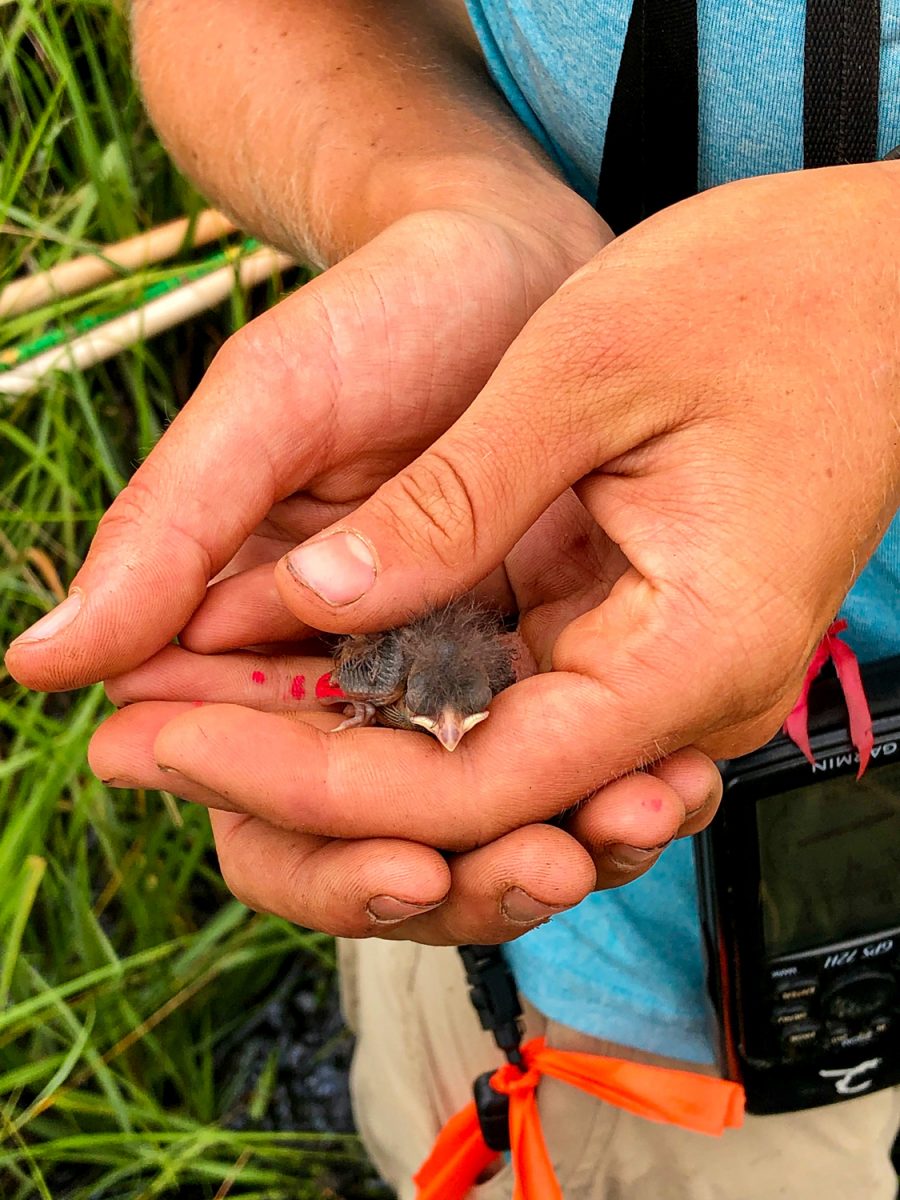
A newly hatched saltmarsh sparrow chick. A dab of red is added to its leg, so it won’t be counted again during other studies. Photo by Joseph Quaderer
In recent years, some of the nests have been fitted with chrome-plated, nickel-sized thermometers set to automatically record the temperature every 15 minutes, like an airliner’s black box. The aggregated data from the thermometers has not been analyzed, but the heat tells the story of each individual nest. An active nest is almost constantly warm. The mother broods on it, keeping it a steady temperature day and night, with only slight fluctuations for 20 to 30 minutes when she needs to leave the nest to feed. If the transponders show a temperature drop that lasts an hour or two, it means the nest was underwater. If the flooding isn’t too extreme, and the chicks don’t drown or the eggs don’t float away, the mother will continue to brood after the flooding subsides. But if the chicks drown or the eggs float away, the mother will abandon the nest. In studying all this information, scientists have determined that nests can flood up to nine times and the eggs still hatch and that a variance in nest height of six centimeters can be the difference between a successful and a flooded nest.
But even if flooding does wipe out all their young, saltmarsh sparrows get right back to laying eggs. Elphick tells me that he doesn’t think female saltmarsh sparrows can somehow divine where they are in the lunar cycle when they start laying eggs. Rather, they arbitrarily start their reproductive cycle, and if it’s not in sync with the lunar cycle, the flooding will likely wipe out the nest. Undeterred, as soon as the flooding subsides, they’ll start laying eggs again—this time perfectly synchronized with the lunar cycle and with a full 28 days to raise their young. It’s a brutal yet efficient way for these tiny birds to harmonize with the moon spinning around the Earth.
At 11 a.m., Cook, Peel, and I head back to the field camp. High tide is just 30 minutes away, and we don’t want to be splashing around with big boots, creating waves that could lift the eggs out of their nests.
The water level has risen nearly a meter, and the desiccated canal behind the camp has become a teeming rivulet. A flock of Canada geese in the canal, debating whether to come ashore, suspiciously watch us as we fold chairs, wrap bungee cords around the bamboo poles, load the scientific gear into bags, and roll up the muddied tarp.
As we’re preparing to leave the salt marsh, my mind drifts back to the eight eggs we found, half of which were added to the jar of death. I wonder what the next tide will bring for these beleaguered creatures.
When I meet with Elphick in Connecticut, he tells me that the clichéd metaphor of a canary in the coal mine is very applicable to the saltmarsh sparrow’s saga.
“The point is not that the canary didn’t do well,” he says. “The point is that the miners took the canary down into the mine because the bird was more sensitive to the gases than humans, but eventually those gases would have affected the humans. The saltmarsh sparrows are more affected by climate change, but it’s a sign of what is coming for us.”
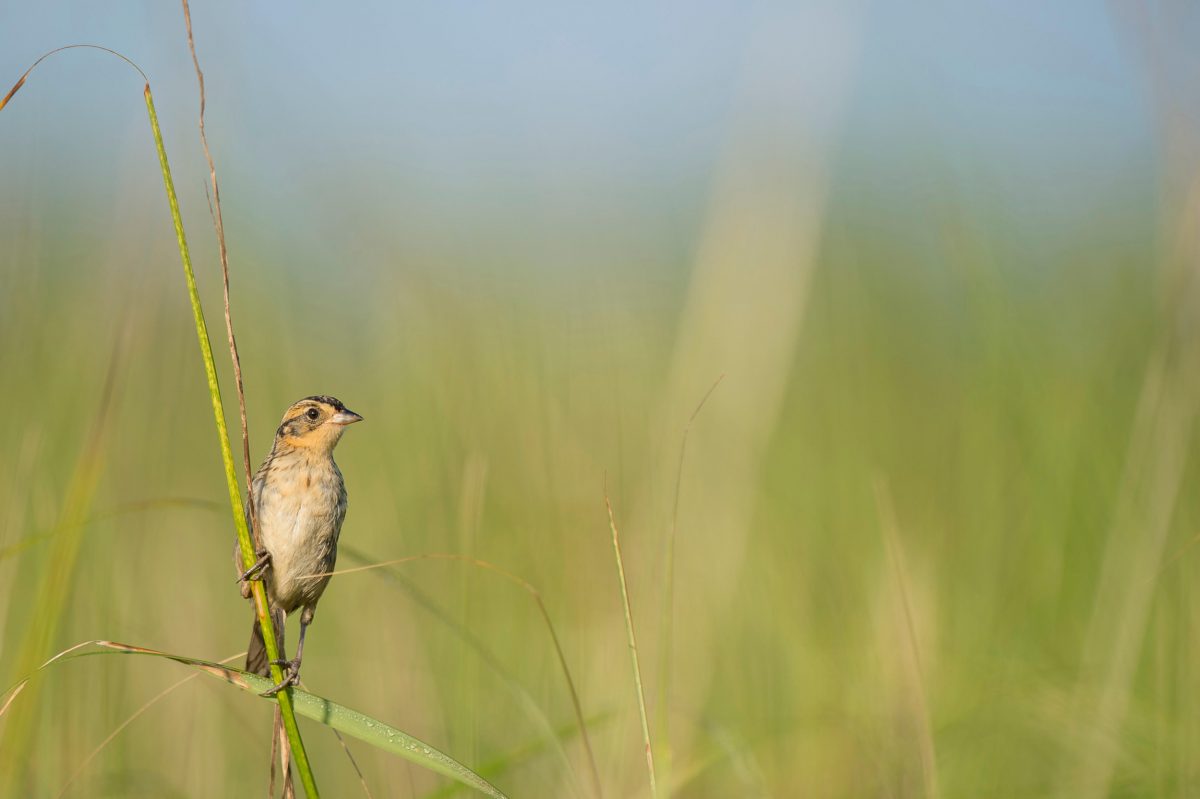
Saltmarsh sparrows are one of North America’s most threatened birds. Much of their habitat is in or near heavily urbanized areas on the Atlantic Coast and is impacted by development, habitat degradation or loss, and the consequences of sea level rise. Photo by Raymond Hennessy/Alamy Stock Photo
Birds and people share the same spaces, and they need those spaces to be healthy. In addition to providing a natural habitat for plants, fish, and other wildlife, the marshes that line the world’s waterways provide buffers against waves and sea level rise, improve water quality, and reduce the damaging effects of hurricanes by absorbing storm energy in ways that neither solid land nor open water can.
There are approximately 1,600 hectares of salt marsh remaining in New York City today, less than 20 percent of the land that existed before human intervention. Slightly over 600 hectares are owned and managed by the New York City Department of Parks and Recreation, which is acquiring additional salt marsh land from other city agencies and private owners so that existing and newly acquired salt marshes can be properly maintained through a number of measures—adding sand to increase the marsh surface elevation, restoring eroded marsh edges, and removing large-scale marine debris.
It is unclear whether these changes will save the saltmarsh sparrow. The city has rebuilt 60 hectares of salt marshes to fortify the New York City coastline and protect its residents, but, thus far, the efforts haven’t appeared to boost the saltmarsh sparrow population.
After finishing all the surveys, Cook’s team grabs the bags full of equipment and we march single file through the noticeably muddier and wetter trail back toward dry land. As we bushwhack back through the taller vegetation, I can no longer see the marsh, but I can still hear the persistent buzz of insects and the staccato calls and songs of the birds behind me. I don’t hear the saltmarsh sparrow. One rarely does. The females never sing, of course, and the males, when they do sing, emit muted wheezy trills and oddly accented syllables. They are quiet birds, but with their vastly declining populations, saltmarsh sparrows are calling out to us as loudly as they can.

